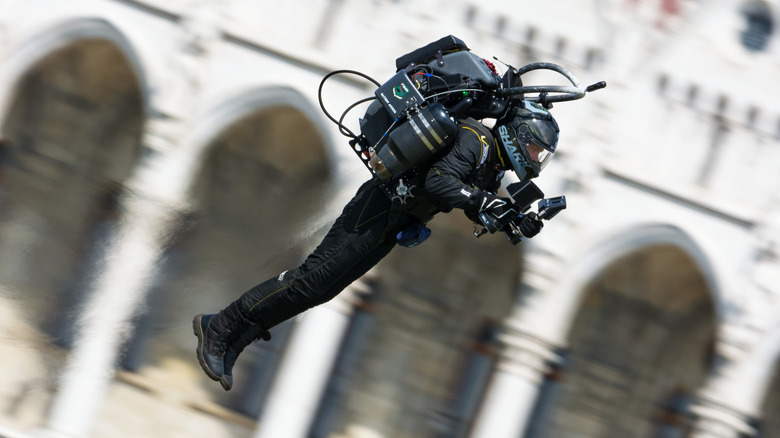How Close Are Humans To Actually Having Jetpacks?
Iconic gadgets exist on a wide spectrum. They can be totally outlandish and physically impossible, like the gravity gun in "Half Life," or they can be a bit closer to reality like one of the communicators from "Star Trek." The jet pack is the best of both worlds — it exists within the realms of possibility, while also allowing its users to move in three dimensions and opening up a world of possibilities. In some works of fiction, jetpacks are a futuristic transport solution, something everyday people use to navigate cities in the sky. In video games like "Halo: Reach," jetpacks add an extra gameplay element.
But is any of this based in reality? Is the military looking into jetpacks in an attempt to get the jump on their opponents? Will civilians ever take to the skies in an attempt to dodge the morning commute? And if jetpacks are a reality, are they really the best transport option?
This is how jet packs work
Although the execution is quite complex, the idea behind a jetpack is pretty simple. Put a harness on some kind of jet engine or rocket, add some way to control the throttle and steering, then pop someone in the harness and wish them luck. The thrust from the rocket or jet applies a force that sends the pack and the person wearing it in the opposite direction. A jetpack's engines have to provide enough thrust to lift the pack and the person operating it, while also being as economic as possible.
Fuel has a lot of weight and takes up space, so only a limited amount can be carried and the jetpack has to make the most of it. The harness is also important, as becoming detached from a jetpack while you're several thousand feet up is a good way to ruin your afternoon. There also needs to be some kind of parachute attached, as a controlled landing isn't really an option if the pack malfunctions or runs out of fuel. Materials like carbon fiber and aluminum tend to feature heavily, as they are both durable and light.
If you have a JB-9 Jetpack strapped to you, your right-hand throttle will control the amount of thrust the engines provide which in turn dictates either your speed or elevation. The left hand adjusts a set of fins attached to the bottom of each jet, which allows for some steering control. The pack also pivots on a ball and socket joint, allowing the user to control the direction they are headed in more easily.
Jetpacks have been around for a while
Popular Science has been chronicling the development of jetpacks since 1958. If you're less picky about your personal flight devices, the magazine goes back even further than that, noting a design for a single-person helicopter as far back as 1940. The 1958 jetpack probably isn't what you're picturing; it wasn't designed for extended periods of flight. Instead, the aptly named "project grasshopper" was a solid fuel device that could be strapped around a soldier's waist. That soldier would then gain a superhuman jumping ability and be capable of clearing a 50-foot wide river or leaping from a second-story window. Grasshopper was amongst the variety of wacky projects the U.S. military was working on in the 1950s. Just like the Air Force's flying saucer project, the jump belts didn't really go anywhere.
A jump belt may sound like something James Bond would have around his waist, but the British spy actually had something a lot better. The movie "Thunderball" saw 007 take a short trip strapped to a Bell-Textron jetpack, which was another device developed for the American military. The United States Army thought the Bell-Textron was a bit too dangerous for its troops, so it didn't end up strapped to the back of any soldiers. However, the cutting-edge gadget was ideal for the world of film despite its very limited range. As Production Designer Ken Adam clarifies (via 007.com), "You could only fly for 20 seconds, then you ran out of fuel and you had nothing." Britain's top spy having a jetpack alongside his laser watch and submarine sports car is one thing, and you can understand the U.S. military dabbling with the technology. But when are regular people going to be flying around with a pack on their back?
A New Zealand-based inventor has contributed heavily
Glenn Martin has been trying to make personal jetpacks a thing for a very long time. The New Zealand-based inventor has been working on his flying machines since the 1980s — and despite several delays, they are now up for sale. A video showing a pilot hovering slightly in one of Martin's models was released in 2009, then in 2012, the inventor released a statement saying he hoped to have his creation on sale that year. Martin's invention is certainly an impressive achievement, but it isn't exactly the kind of jetpack you'd see in a sci-fi movie. They're pretty huge and closer to a small vehicle than they are a propellant-filled backpack. Still, Martin envisages a world where most people use his creation as an everyday transport option.
Production was originally limited to around 500 per year, with plans to scale it up as demand increases. The $100,000 plus price tag may seem like a barrier at first, but it probably isn't the issue that is holding jetpacks like Martin's back — people pay six figures for cars all the time, after all. A high-end electric vehicle like a Tesla Model S Plaid or a Lucid Air can easily cost you that, as will gasoline-powered luxury cars like the Range Rover or a Porsche. Jetpacks do have real-world applications beyond dodging traffic, as well. For example, search and rescue teams and disaster response services can use them to gain a better view of a situation. Although drones have similar — if not better — reconnaissance abilities, a jetpack has the added benefit of getting a responder to the scene as quickly as possible.
Personal jetpack flight isn't that strictly regulated
The FAA, like most government agencies, is great at ruining people's fun. You can't operate a small drone in public without passing a test and being licensed, so there's no chance you can whizz around with a jet engine strapped to your body without the authorities getting upset, right? Wrong. There's actually far less regulation related to jetpack flight than you'd think. This is because, for regulation purposes, jetpacks are technically ultralight aircraft if the jetpack in question weighs less than 254 pounds when empty, has a fuel tank capacity smaller than five U.S. gallons, and isn't capable of going faster than 55 knots.
According to the FAA and the Pilot Insitute, you don't need to pass a test, log a specific number of flight hours, or hold a license to pilot an ultralight aircraft. Airspace below 400 feet isn't regulated outside of cities and the areas around airports either, so air traffic control won't bother you. So if you get a jetpack that ticks all the boxes, you may be able to just strap it on and take off without the government stepping in.
However, there are some regulations. You won't be able to fly your jetpack near an airport or a residential area without approval, you have to fly during daylight hours and decent weather, and you can't bring any passengers along. All other aircraft also have right of way over ultra lights — so if you spot a plane, you need to move. There's also the fact that if jetpacks become extremely popular, they will almost certainly end up with their own specific legislation, rules, and licensing procedures, possibly ones similar to drone regulations, according to FindLaw. If you want to take to the skies during the jetpack's Wild West period, you'll have to do it before everyone else does.
You can buy one right now, but you may not want to
Given all of that, how close are humans to actually having jetpacks? Well, you can have one right now, though it will cost you about as much as a small house will and have near no practical use. If you have a few hundred dollars spare, here are your options. Glenn Martin's jetpack is available starting at $100,000 and can travel at speeds of up to 50 miles per hour, launch its user up to 800 feet in the air, and clock about 30 minutes of flight time before the fuel level gets low. Jetpack Aviation also has a couple of models on offer but hasn't listed any prices.
Expense aside, jetpacks are pretty impractical, and that's something that is unlikely to change. If your destination is more than 25 miles away, you'll probably be arriving by parachute. Then there's the general public to consider. People don't behave themselves, especially when there's fun to be had. If you give someone a fast car, a motorcycle, or a speedboat, they're probably going to push it to the limits and get some adrenaline flowing. Things are bad enough with vehicles at sea level; if jetpacks become popular, folks will be waking up to a live-action Elton John hit crashing head first into their garden shed.
If jetpacks aren't the future, short-distance travel may still be airborne. Air Taxi projects are receiving billions of dollars in investments from the likes of Boeing, American Airlines, and United Airlines. If you're somewhat well off and trying to beat the rush hour traffic in a few years' time, you'll probably be hopping on board a small, self-flying, plane instead of strapping on a rocket belt.



